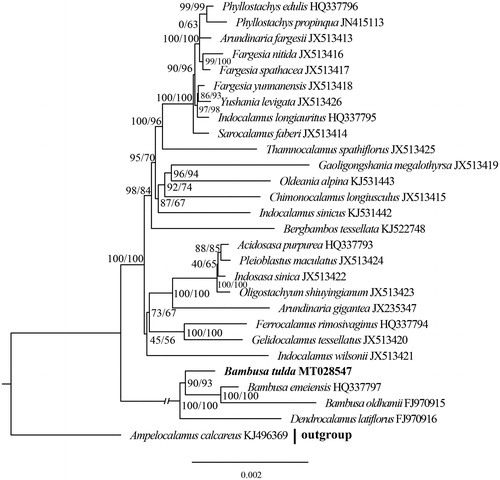Abstract
Bambusa is an economically and ornamental woody bamboo genus. The complete plastid genome of B. tulda was determined and analyzed in this study. The genome was 139,536 bp in length, including a large single copy region (LSC) of 83,091 bp and a small single copy region (SSC) of 12,893 bp, and two inverted repeat regions (IR) of 21,776 bp. The plastid genome contained 132 genes, which comprised 85 protein-coding genes, eight ribosomal RNA genes, and 39 transfer RNA genes.
Keywords:
Bambusa is one of the largest genera of woody bamboos, containing more than 100 species (Yang et al. Citation2010), which is distributed in the tropics and subtropics from southern Asia to the Pacific Rim, and most of them are high economic value and extensive utility. Bambusa tulda is a costly bamboo which is endemic to northeastern region and West Bengal of India. It is a good material for various handicraft works, house building, paper industries, and other equipment for daily life (Singh et al. Citation2010). The present study acquired a complete plastid genome of B. tulda to investigate the plastid genome feature and phylogenetic position; it also provided the genetic material for evolution and breeding study.
The sample was acquired from Cangshan District, Fujian Province of China (26°38′N, 119°27′E), and the voucher specimen deposited at Herbarium of Fujian Agriculture and Forestry University (specimen code HTY008). The total genomic DNA extraction, library constructing, sequencing and data filtering of B. tulda were referenced in Liu et al. (Citation2020). The plastid genome of B. oldhamii (FJ970915) as reference, the paired-end reads were filtered with GetOrganelle pipe-line (Jin et al. Citation2018) to get plastid-like reads, then the filtered reads were assembled using SPAdes version 3.10 (Bankevich et al. Citation2012). The final ‘fastg’ was filtered by the script of GetOrganelle to get pure plastid contigs, and the filtered ‘De Brujin’ graphs were viewed and edited by Bandage (Wick et al. Citation2015). Assembled plastid genome annotation based on comparison with B. oldhamii using GENEIOUS v11.1.5 (Biomatters Ltd., Auckland, New Zealand) (Kearse et al. Citation2012). The matrix of 28 representative species of the tribe Bambuseae was aligned using MAFFT v7.307 (Katoh and Standley Citation2013). The phylogenetic tree was constructed using the maximum-likelihood software IQ-TREE (Nguyen et al. Citation2015) based on the complete plastid genomes; and branch supports with the ultrafast bootstrap (Hoang et al. Citation2018). These analyses are performed in the Phylosuite platform (Zhang et al. Citation2020)
The complete B. tulda (GenBank accession MT028547) plastid genome is a quadripartite structure with the length of 139,536 bp, contains a large single copy region (LSC) of 83,091 bp, a small single copy (SSC) region of 12,893 bp, and two inverted repeat (IR) regions of 21,776 bp. The new sequence possesses total 132 genes, including 85 protein-coding genes, eight rRNA genes, and 39 tRNA genes. The overall GC content of the chloroplast genome was 38.9%, whereas the corresponding values of the LSC, SSC, and IR regions are 37.0%, 33.0%, and 44.2%, respectively. The phylogenetic analysis result showed Bumbusa is monophyletic, and B. tulda is sister to B. emeiensis plus B. emeiensis with strong support ().
Disclosure statement
No potential conflict of interest was reported by the author(s).
Additional information
Funding
References
- Bankevich A, Nurk S, Antipov D, Gurevich AA, Dvorkin M, Kulikov AS, Lesin VM, Nikolenko SI, Pham S, Prjibelski AD, Pyshkin AV, et al. 2012. SPAdes: a new genome assembly algorithm and its applications to single-cell sequencing. J Comput Biol. 19(5):455–477.
- Hoang DT, Chernomor O, von Haeseler A, Minh BQ, Vinh LS. 2018. UFBoot2: improving the ultrafast bootstrap approximation. Mol Biol Evol. 35(2):518–522.
- Jin JJ, Yu WB, Yang JB, Song Y, Yi TS, Li DZ. 2018. GetOrganelle: a fast and versatile toolkit for accurate de novo assembly of organelle genomes. bioRxiv. 256479.
- Katoh K, Standley DM. 2013. MAFFT multiple sequence alignment software version 7: improvements in performance and usability. Mol Biol Evol. 30(4):772–780.
- Kearse M, Moir R, Wilson A, Stones-Havas S, Cheung M, Sturrock S, Buxton S, Cooper A, Markowitz S, Duran C, et al. 2012. Geneious Basic: an integrated and extendable desktop software platform for the organization and analysis of sequence data. Bioinformatics. 28(12):1647–1649.
- Liu DK, Tu XD, Zhao Z, Zeng MY, Zhang S, Ma L, Zhang GQ, Wang MM, Liu ZJ, Lan SR, et al. 2020. Plastid phylogenomic data yield new and robust insights into the phylogeny of Cleisostoma–Gastrochilus clades (Orchidaceae, Aeridinae). Mol Phylogenet Evol. 145:106729.
- Nguyen LT, Schmidt HA, von Haeseler A, Minh BQ. 2015. IQ-TREE: a fast and effective stochastic algorithm for estimating Maximum-Likelihood phylogenies. Mol Biol Evol. 32(1):268–274.
- Singh KP, Devi SP, Devi KK, Ningombam DS, Athokpam P. 2010. Bambusa tulda Roxb. in Manipur State, India: exploring the local values and commercial implications. Not Sci Biol. 2(2):35–40.
- Wick RR, Schultz MB, Zobel J, Holt KE. 2015. Bandage: interactive visualization of de novo genome assemblies. Bioinformatics. 31(20):3350–3352.
- Yang JB, Yang HQ, Li DZ, Wong KM, Yang YM. 2010. Phylogeny of Bambusa and its allies (Poaceae: Bambusoideae) inferred from nuclear GBSSI gene and plastid psbA-trnH, rpl32-trnL and rps16 intron DNA sequences. Taxon. 59(4):1102–1110.
- Zhang D, Gao FL, Jakovlić I, Li WX, Zhou H, Zhang J, Wang GT. 2020. PhyloSuite: an integrated and scalable desktop platform for streamlined molecular sequence data management and evolutionary phylogenetics studies. Mol Ecol Resour.20(1):348–355.

